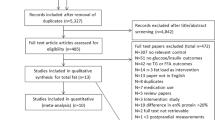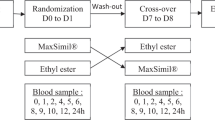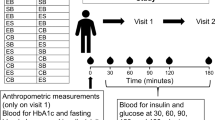Abstract
Background/objectives
Emulsified lipids, with central lipid core surrounded by polar lipid ‘protective coat’, have been proposed to stimulate the ileal brake, alter appetite, food intake and aid weight control. In addition to lipid composition, emulsion particle size may contribute to efficacy with small droplets providing a larger surface area for gastrointestinal (GI) lipase action and larger droplets prolonging and delaying digestion in the GI tract. Tube feeding studies delivering emulsions directly into the small intestine show clear effects of smaller particle size on appetite and food intake, but evidence from oral feeding studies is sparse. The objective of this study was to determine the effects of lipid emulsion particle size on appetite response and food intake.
Subjects/methods
In a three-arm randomised cross-over, high-phospholipid (PL) dairy lipid emulsions or matched control were consumed at breakfast within a yoghurt smoothie: (i) large-particle size emulsion, LPE (diameter 0.759 µm, 10 g lipid emulsion, 190 g yoghurt), (ii) small-particle size emulsion, SPE (diameter 0.290 µm, 10 g lipid emulsion, 190 g yoghurt), (iii) control non-emulsion, NE (10 g non-emulsion lipid, 190 g yoghurt). Twenty male participants completed the study, where postprandial appetite response was rated using visual analogue scales (VAS) and ad libitum energy intake at a lunch meal measured 3 h later.
Results
There was a trend for LPE to suppress hunger (P = 0.08) and enhance fullness (P = 0.24) relative to both SPE and NE but not statistically significant, and no significant effect of either emulsion on food intake at the lunch meal (P > 0.05).
Conclusions
Altering particle size of a high-PL emulsion did not enhance satiety or alter eating behaviour in a group of lean men.
This is a preview of subscription content, access via your institution
Access options
Subscribe to this journal
Receive 12 print issues and online access
$259.00 per year
only $21.58 per issue
Buy this article
- Purchase on Springer Link
- Instant access to full article PDF
Prices may be subject to local taxes which are calculated during checkout




Similar content being viewed by others
References
Mela DJ, Boland MJ Applying structuring approaches for satiety: challenges faced, lessons learned. In: Boland M, Golding M, Singh H, editors. Food structures, digestion and health. London: Elsevier Inc; 2014. p. 363–88.
Maljaars PWJ, Keszthelyi D, Masclee AAM. An ileal brake-through? Am J Clin Nutr. 2010;92:467–8.
Knutson L, Koenders DJPC, Fridblom H, Viberg A, Sein A, Lennernäs H. Gastrointestinal metabolism of a vegetable-oil emulsion in healthy subjects. Am J Clin Nutr. 2010;92:515–24.
Maljaars PWJ, Peters HPF, Mela DJ, Masclee AAM. Ileal brake: a sensible food target for appetite control. A review. Physiol Behav. 2008;95:271–81.
Shin HS, Ingram JR, McGill AT, Poppitt SD. Lipids, CHOs, proteins: can all macronutrients put a ‘brake’ on eating? Physiol Behav. 2013;120:114–23.
Seimon RV, Wooster T, Otto B, Golding M, Day L, Little TJ, et al. The droplet size of intraduodenal fat emulsions influences antropyloroduodenal motility, hormone release, and appetite in healthy males. Am J Clin Nutr. 2009;89:1729–36.
Maljaars PWJ, van der Wal RJP, Wiersma T, Peters HPF, Haddeman E, Masclee AAM. The effect of lipid droplet size on satiety and peptide secretion is intestinal site-specific. Clin Nutr. 2012;31:535–42.
Maljaars J, Romeyn EA, Haddeman E, Peters HPF, Masclee AAM. Effect of fat saturation on satiety, hormone release, and food intake. Am J Clin Nutr. 2009;89:1019–24.
Maljaars PWJ, Peters HPF, Kodde A, Geraedts M, Troost FJ, Haddeman E, et al. Length and site of the small intestine exposed to fat influences hunger and food intake. Br J Nutr. 2011;106:1609–15.
Maljaars PWJ, Symersky T, Kee BC, Haddeman E, Peters HPF, Masclee AAM. Effect of ileal fat perfusion on satiety and hormone release in healthy volunteers. Int J Obes. 2008;32:1633–9.
Van Avesaat M, Troost FJ, Ripken D, Hendriks HF, Aam M. Ileal brake activation: macronutrient-specific effects on eating behavior? Int J Obes. 2015;39:235–43.
Poppitt SD, Shin HS, McGill AT, Budgett S, Lo K, Pahl M, et al. Duodenal and ileal glucose infusions differentially alter gastrointestinal peptides, appetite response and food intake: a tube feeding study. Am J Clin Nutr. 2017;106:1–11.
Alleleyn AME, Van Avesaat M, Troost FJ, Masclee AAM. Gastrointestinal nutrient infusion site and eating behavior: Evidence for a proximal to distal gradient within the small intestine? Nutrients. 2016;8:117.
Le Roux CW, Aylwin SJB, Batterham RL, Borg CM, Coyle F, Prasad V, et al. Gut hormone profiles following bariatric surgery favor an anorectic state, facilitate weight loss, and improve metabolic parameters. Ann Surg. 2006;243:108–14.
Burns AA, Livingstone MBE, Welch RW, Dunne A, Robson PJ, Lindmark L, et al. Short-term effects of yoghurt containing a novel fat emulsion on energy and macronutrient intakes in non-obese subjects. Int J Obes. 2000;24:1419–25.
Burns AA, Livingstone MBE, Welch RW, Dunne A, Reid CA, Rowland IR. The effects of yoghurt containing a novel fat emulsion on energy and macronutrient intakes in non-overweight, overweight and obese subjects. Int J Obes. 2001;25:1487–96.
Burns AA, Livingstone MBE, Welch RW, Dunne A, Rowland IR. Dose-response effects of a novel fat emulsion (Olibra™) on energy and macronutrient intakes up to 36h post-consumption. Eur J Clin Nutr. 2002;56:368–77.
Haenni A, Sundberg B, Yazdanpandah N, Viberg A, Olsson J. Effect of fat emulsion (Fabuless) on orocecal transit time in healthy men. Scand J Gastroenterol. 2009;44:1186–90.
Logan CM, McCaffrey TA, Wallace JMW, Robson PJ, Welch RW, Dunne A, et al. Investigation of the medium-term effects of Olibra™ fat emulsion on food intake in non-obese subjects. Eur J Clin Nutr. 2006;60:1081–91.
Smit HJ, Keenan E, Kovacs EMR, Wiseman SA, Peters HPF, Mela DJ, et al. No efficacy of processed Fabuless (Olibra) in suppressing appetite or food intake. Eur J Clin Nutr. 2011;65:81–86.
Diepvens K, Steijns J, Zuurendonk P, Westerterp-Plantenga MS. Short-term effects of a novel fat emulsion on appetite and food intake. Physiol Behav. 2008;95:114–7.
Smit HJ, Keenan E, Kovacs EMR, Wiseman SA, Mela DJ, Rogers PJ. No appetite efficacy of a commercial structured lipid emulsion in minimally processed drinks. Int J Obes. 2012;36:1222–8.
Chan YK, Strik CM, Budgett SC, McGill AT, Proctor J, Poppitt SD. The emulsified lipid Fabuless (Olibra) does not decrease food intake but suppresses appetite when consumed with yoghurt but not alone or with solid foods: a food effect study. Physiol Behav. 2012;105:742–8.
Poppitt SD, Han S, Strik CM, Kindleysides S, Chan YK. Investigating acute satiation and meal termination effects of a commercial lipid emulsion: a breakfast meal study. Physiol Behav. 2015;152:20–25.
Chan YK, Budgett SC, MacGibbon AK, Quek SY, Kindleysides S, Poppitt SD. Small particle size lipid emulsions, satiety and energy intake in lean men. Physiol Behav. 2017;169:98–105.
Ohlsson L, Rosenquist A, Rehfeld JF, Harrod M. Postprandial effects on plasma lipids and satiety hormones from intake of liposomes made from fractionated oat oil: two randomized crossover studies. Food Nutr Res. 2014;58:24465.
Hussein MO, Hoad CL, Wright J, Singh G, Stephenson MC, Cox EF, et al. Fat emulsion intragastric stability and droplet size modulate gastrointestinal responses and subsequent food intake in young adults. J Nutr. 2015;145:1170–7.
Favé G, Coste TC, Armand M. Physicochemical properties of lipids: new strategies to manage fatty acid bioavailability. Cell Mol Biol. 2004;50:815–31.
Armand M, Pasquier B, André M, Borel P, Senft M, Peyrot J, et al. Digestion and absorption of 2 fat emulsions with different droplet sizes in the human digestive tract. Am J Clin Nutr. 1999;70:1096–106.
Blundell J, De Graaf C, Hulshof T, Jebb S, Livingstone B, Lluch A, et al. Appetite control: methodological aspects of the evaluation of foods. Obes Rev. 2010;11:251–70.
Poppitt SD, Strik CM, MacGibbon AKH, McArdle BH, Budgett SC, McGill AT. Fatty acid chain length, postprandial satiety and food intake in lean men. Physiol Behav. 2010;101:161–7.
Poppitt SD, Strik CM, McArdle BH, McGill AT, Hall RS. Evidence of enhanced serum amino acid profile but not appetite suppression by dietary glyco-macropeptide (GMP): a comparison of dairy whey proteins. J Am Coll Nutr. 2013;32:177–86.
Shin HS, Kindleysides S, Yip W, Budgett SC, Ingram JR, Poppitt SD. Postprandial effects of a polyphenolic grape extract (PGE) supplement on appetite and food intake: a randomised dose-comparison trial. Nutr J. 2015;14:96.
Wiessing KR, Xin L, McGill AT, Budgett SC, Strik CM, Poppitt SD. Sensitivity of ad libitum meals to detect changes in hunger. Restricted-item or multi-item testmeals in the design of preload appetite studies. Appetite. 2012;58:1076–82.
Lin HC, Zhao XT, Wang L. Intestinal transit is more potently inhibited by fat in the distal (ileal brake) than in the proximal (jejunal brake) gut. Dig Dis Sci. 1997;42:19–25.
Read NW, McFarlane A, Kinsman RI, Bates TE, Blackhall NW, Farrar GBJ, et al. Effect of infusion of nutrient solutions into the ileum on gastrointestinal transit and plasma levels of neurotensin and enteroglucagon. Gastroenterology. 1984;86:274–80.
Spiller RC, Trotman IF, Higgins BE, Ghatei MA, Grimble GK, Lee YC, et al. The ileal brake - inhibition of jujunal motility after ileal fat perfusion in man. Gut. 1984;25:365–74.
Welch I, Saunders K, Read NW. Effect of ileal and intravenous infusions of fat emulsions on feeding and satiety in human volunteers. Gastroenterology. 1985;89:1293–7.
Hursel R, Westerterp-Plantenga M. The effects of a novel fat emulsion (Olibra/Fabuless TM) on energy intake, satiety, weight loss, and weight maintenance. Oxford, UK: Blackwell Publishing; 2010.
Diepvens K, Soenen S, Steijns J, Arnold M, Westerterp-Plantenga M. Long-term effects of consumption of a novel fat emulsion in relation to body-weight management. Int J Obes. 2007;31:942–9.
Borel P, Armand M, Pasquier B, Senft M, Lafont H, Lairon D, et al. Digestion and absorption of tube-feeding emulsions with different droplet sizes and compositions in the rat. J Parenter Enteral Nutr. 1994;18:534–43.
Acknowledgements
We thank Eddie Yao and Sally Xiong for preparation and analysis of lipid emulsion PS and stability. Dr Anne-Thea McGill, Sunnie Xin, Cathy Zhong and Shelley Baty assisted in the conduct of the trial. Funding for this intervention study was provided by LactoPharma, New Zealand. Fonterra Co-operative provided ingredients for preparation of the lipid/water emulsions.
Author contributions
S.D.P.: Principal investigator, protocol design, data analysis and interpretation, lead writer for manuscript. S.C.B.: Statitican analysis of the data set. A.K.M.: Preparation of lipid products. S.-Y.Q.: Oversight of development and preparation of emulsion, analysis of lipid particle size. S.K.: Manuscript preparation. K.R.W.: Trial manager, recruitment, screening and conduct of study.
Author information
Authors and Affiliations
Corresponding author
Ethics declarations
Conflict of interest
S.D.P. is the Fonterra Chair of Human Nutrition, University of Auckland, New Zealand. A.K.M. is an employee of Fonterra Co-operative Group, New Zealand. The remaining authors declare that they have no competing interests
Rights and permissions
About this article
Cite this article
Poppitt, S.D., Budgett, S.C., MacGibbon, A.K. et al. Effects of lipid emulsion particle size on satiety and energy intake: a randomised cross-over trial. Eur J Clin Nutr 72, 349–357 (2018). https://doi.org/10.1038/s41430-017-0016-7
Received:
Revised:
Accepted:
Published:
Issue Date:
DOI: https://doi.org/10.1038/s41430-017-0016-7



